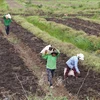Hydro-electricity plants will adjust their operations to provide enough water for agriculture production and domestic use in the lowlands of Thu Bon-Vu Gia rivers.
This was stated by leaders of the Ministry of Agriculture and Rural Development and Electricity of Vietnam (EVN) on May 10.
The move aims to respond to the urge of leaders of central Quang Nam Province and Da Nang City when the Vu Gia-Thu Bon rivers fail to supply water for domestic use and production.
The local leaders said there should be a co-operation mechanism to ensure the plants save water for thousands of hectares of rice fields and more than one million people in the lowlands.
Vu Xuan Khu, deputy director of the National Load Dispatch Centre of EVN, said A Vuong Reservoir currently with 99 million cubic metres and Dak Mi 4 reservoir with 129 million cubic metres would provide enough water for agriculture production and domestic use.
EVN would ask Dak Mi 4 Hydro-Electricity Plant to discharge water at 50cu m per second and A Vuong Hydro-Electricity Plant at 39cu m per second, according to the local production plans, he said.
However, the localities should update their developments to EVN so that it could make suitable adjustments to the operations of these plants, he said.
Dang Duy Hien, deputy director of the Water Works Management Department under the Ministry of Agriculture and Rural Development, said the unfavourable weather would make it difficult to reconcile electricity generation with agriculture production and domestic use.
He said the localities should work out suitable plans for drought prevention at different points of time.
Quang Nam Province should prepare new types of seeds to adapt to drought and clean up their canals. And Da Nang City should store enough water to ensure water supply for its people, he said.
About 20 out of 74 reservoirs in Quang Nam Province were not full, leading to a lack of water for 5,000ha of rice fields. Salt intrusion into the estuaries was also happening.
According to the province's department, it was forecast that more than 11,000ha of rice fields would fall into serious drought if there was no rain between June and August.
Da Nang City was also at a high risk of water deprivation for domestic use and production because salt intrusion had occurred in the Cau Do River, the main source for the Cau Do Water Supply Factory.
The factory is pumping water from An Trach Dam, 8km away. The city's people would have to suffer from water cuts if there was a problem with the pipeline system.
According to the leaders of the ministry and EVN, in case the localities still face a shortage of water for the sowing period at the beginning of next month, the hydro-electricity plants would be instructed to let out water for domestic use and agriculture production.-VNA
This was stated by leaders of the Ministry of Agriculture and Rural Development and Electricity of Vietnam (EVN) on May 10.
The move aims to respond to the urge of leaders of central Quang Nam Province and Da Nang City when the Vu Gia-Thu Bon rivers fail to supply water for domestic use and production.
The local leaders said there should be a co-operation mechanism to ensure the plants save water for thousands of hectares of rice fields and more than one million people in the lowlands.
Vu Xuan Khu, deputy director of the National Load Dispatch Centre of EVN, said A Vuong Reservoir currently with 99 million cubic metres and Dak Mi 4 reservoir with 129 million cubic metres would provide enough water for agriculture production and domestic use.
EVN would ask Dak Mi 4 Hydro-Electricity Plant to discharge water at 50cu m per second and A Vuong Hydro-Electricity Plant at 39cu m per second, according to the local production plans, he said.
However, the localities should update their developments to EVN so that it could make suitable adjustments to the operations of these plants, he said.
Dang Duy Hien, deputy director of the Water Works Management Department under the Ministry of Agriculture and Rural Development, said the unfavourable weather would make it difficult to reconcile electricity generation with agriculture production and domestic use.
He said the localities should work out suitable plans for drought prevention at different points of time.
Quang Nam Province should prepare new types of seeds to adapt to drought and clean up their canals. And Da Nang City should store enough water to ensure water supply for its people, he said.
About 20 out of 74 reservoirs in Quang Nam Province were not full, leading to a lack of water for 5,000ha of rice fields. Salt intrusion into the estuaries was also happening.
According to the province's department, it was forecast that more than 11,000ha of rice fields would fall into serious drought if there was no rain between June and August.
Da Nang City was also at a high risk of water deprivation for domestic use and production because salt intrusion had occurred in the Cau Do River, the main source for the Cau Do Water Supply Factory.
The factory is pumping water from An Trach Dam, 8km away. The city's people would have to suffer from water cuts if there was a problem with the pipeline system.
According to the leaders of the ministry and EVN, in case the localities still face a shortage of water for the sowing period at the beginning of next month, the hydro-electricity plants would be instructed to let out water for domestic use and agriculture production.-VNA



















